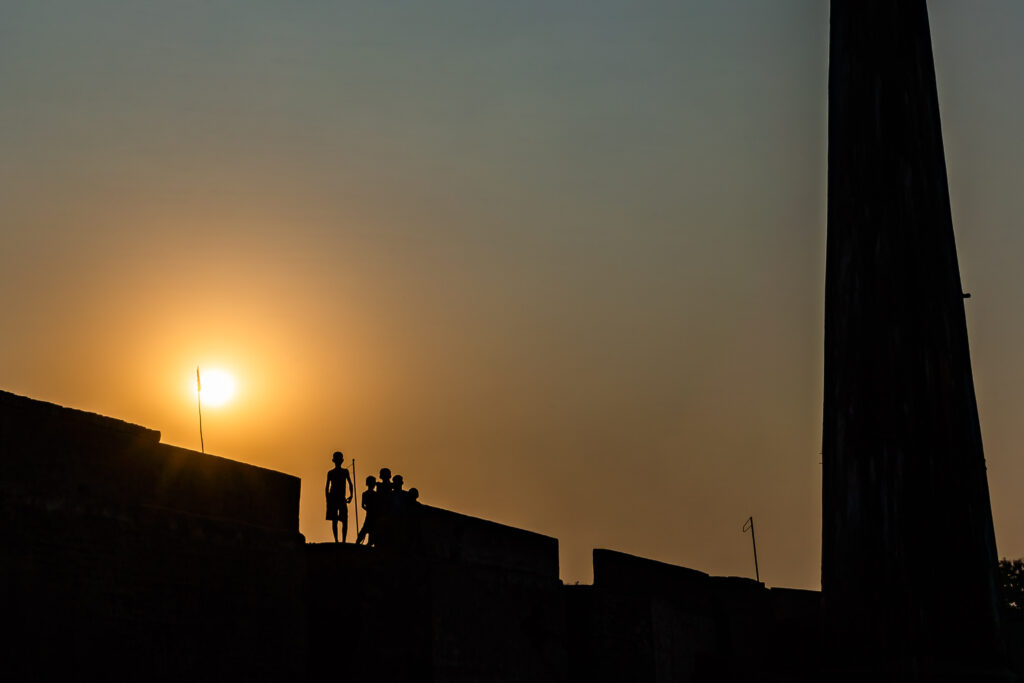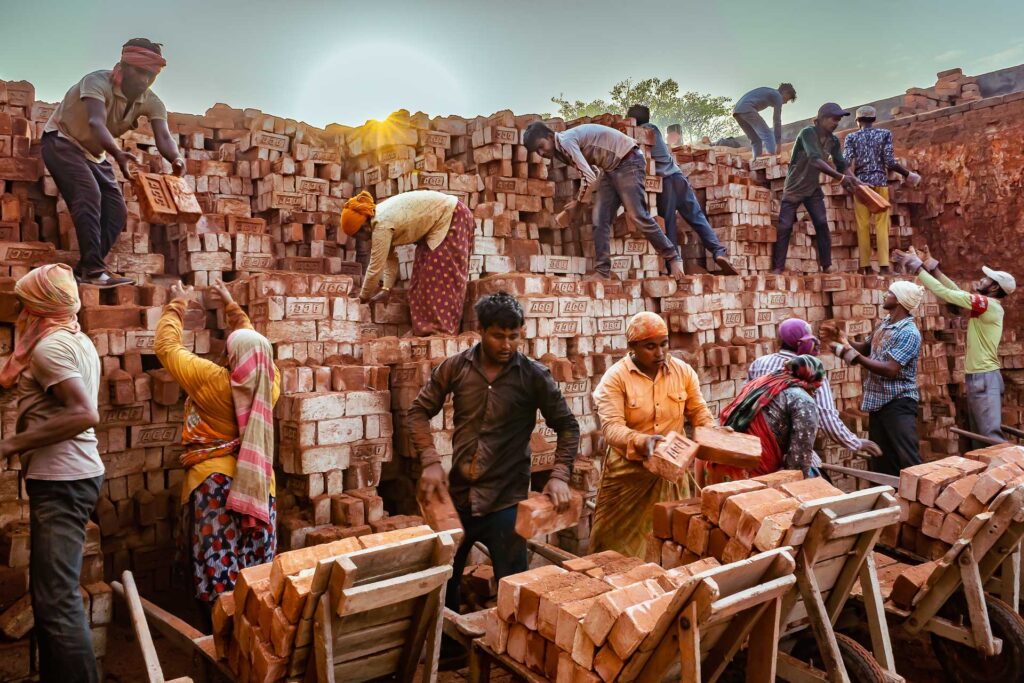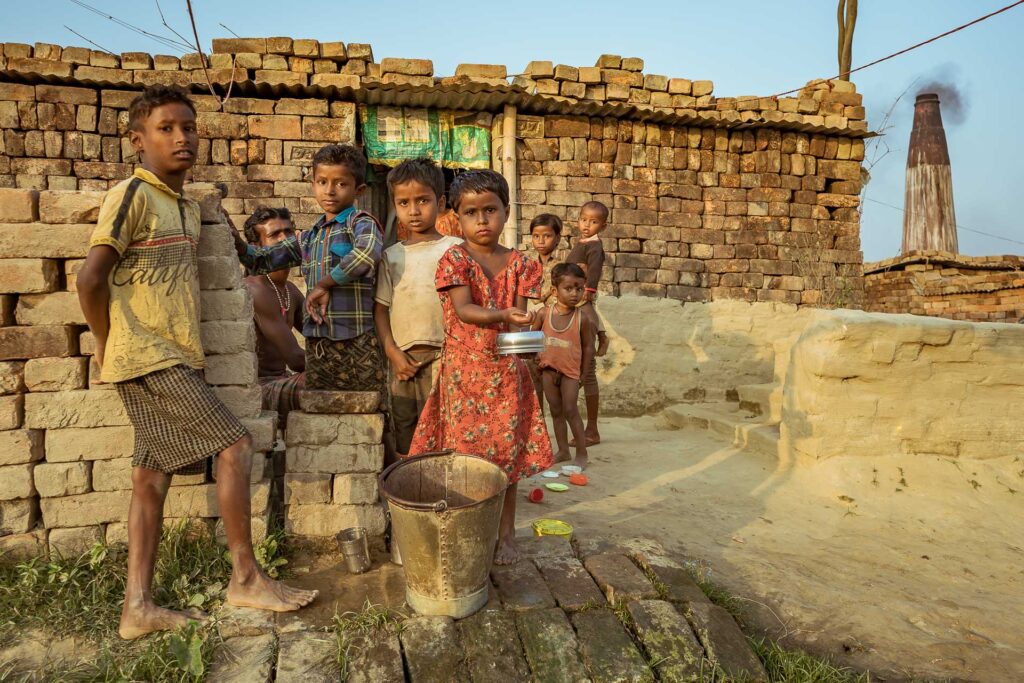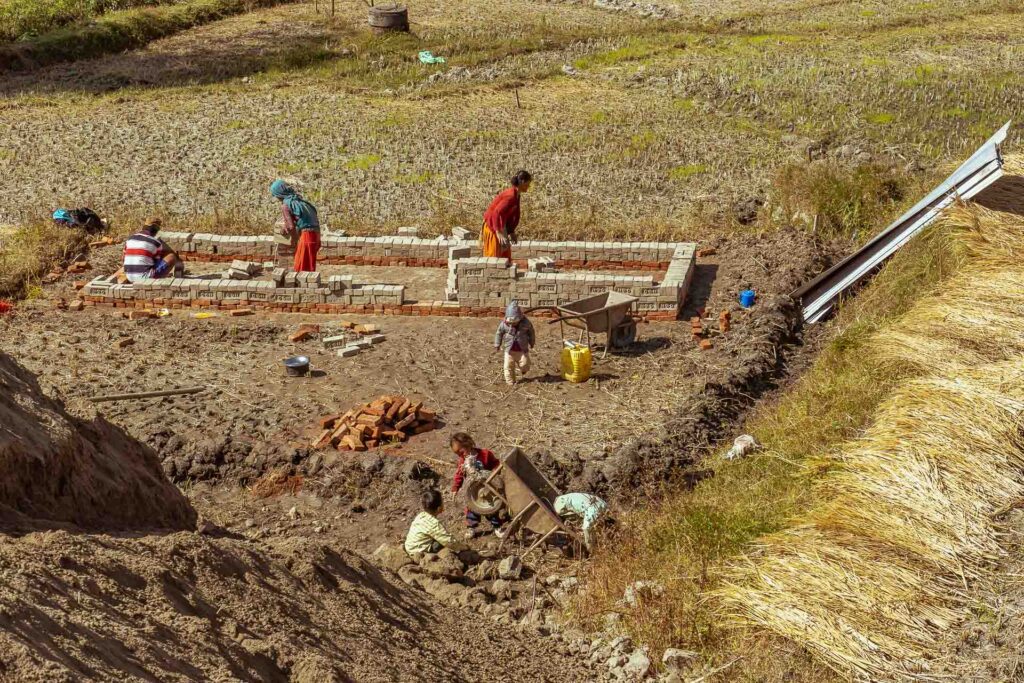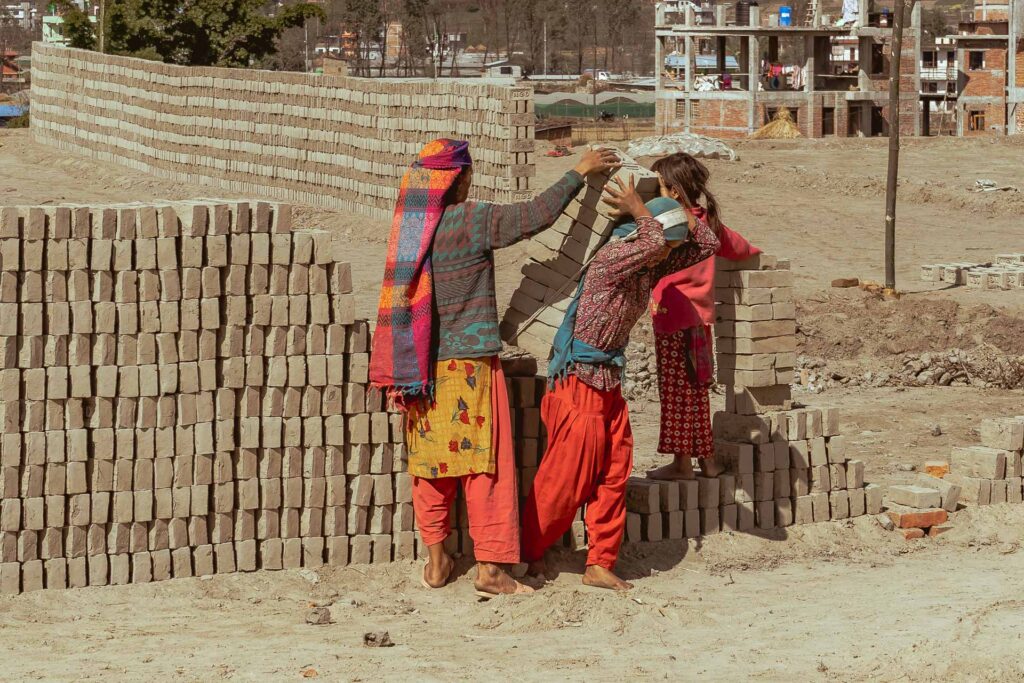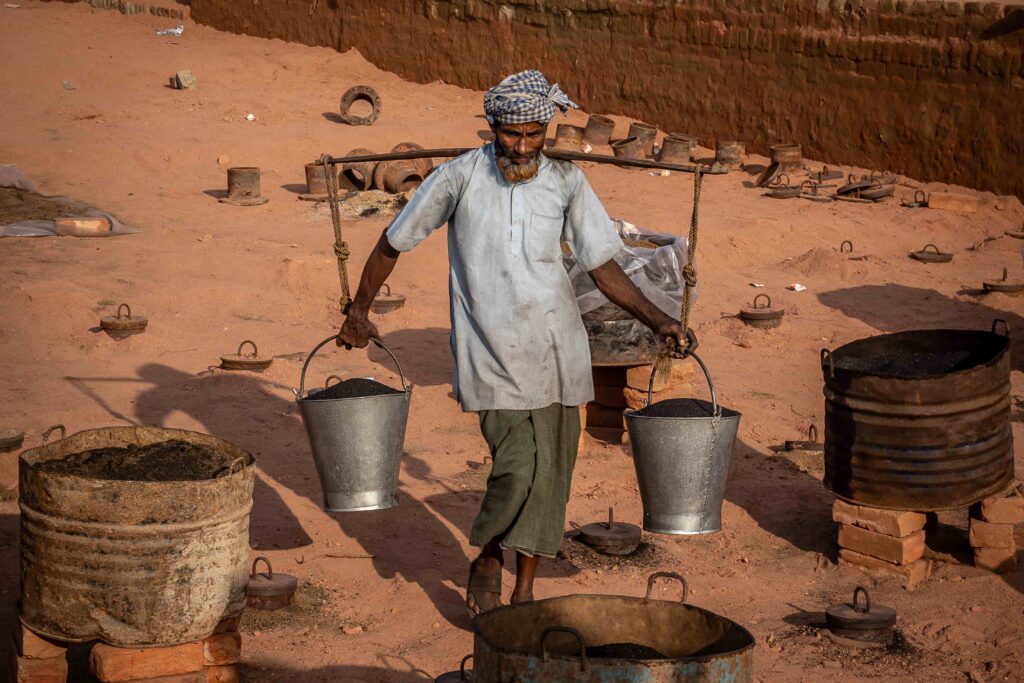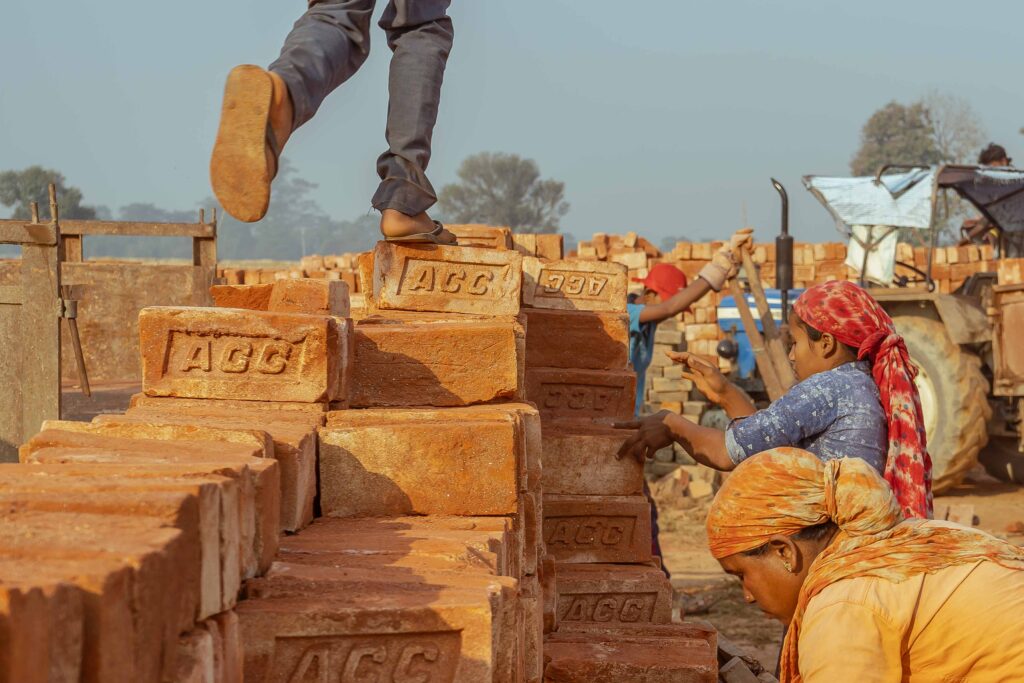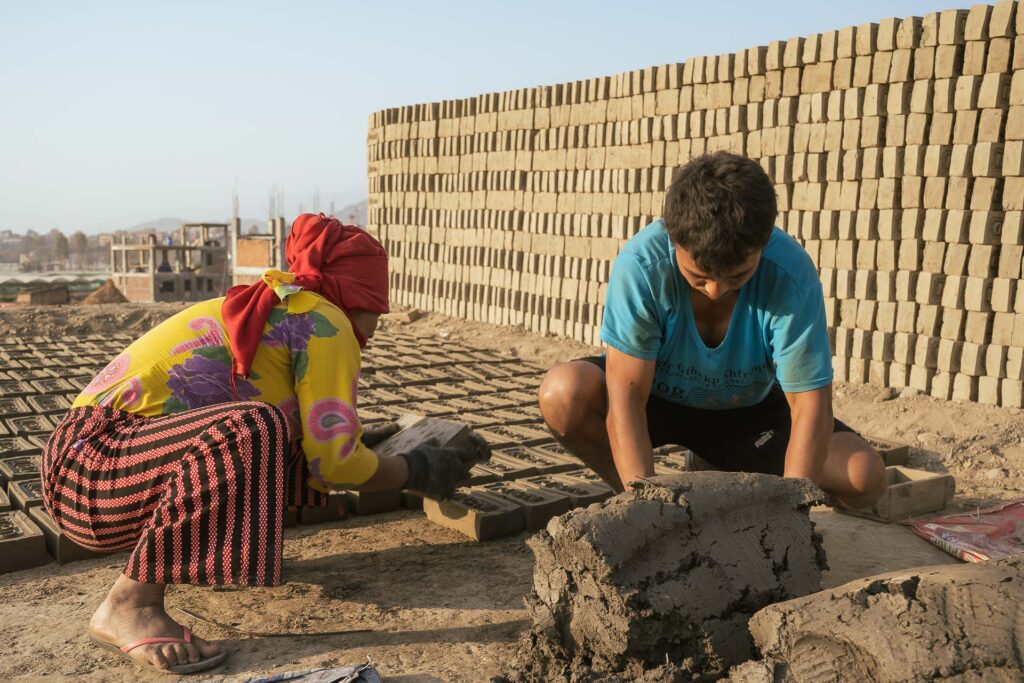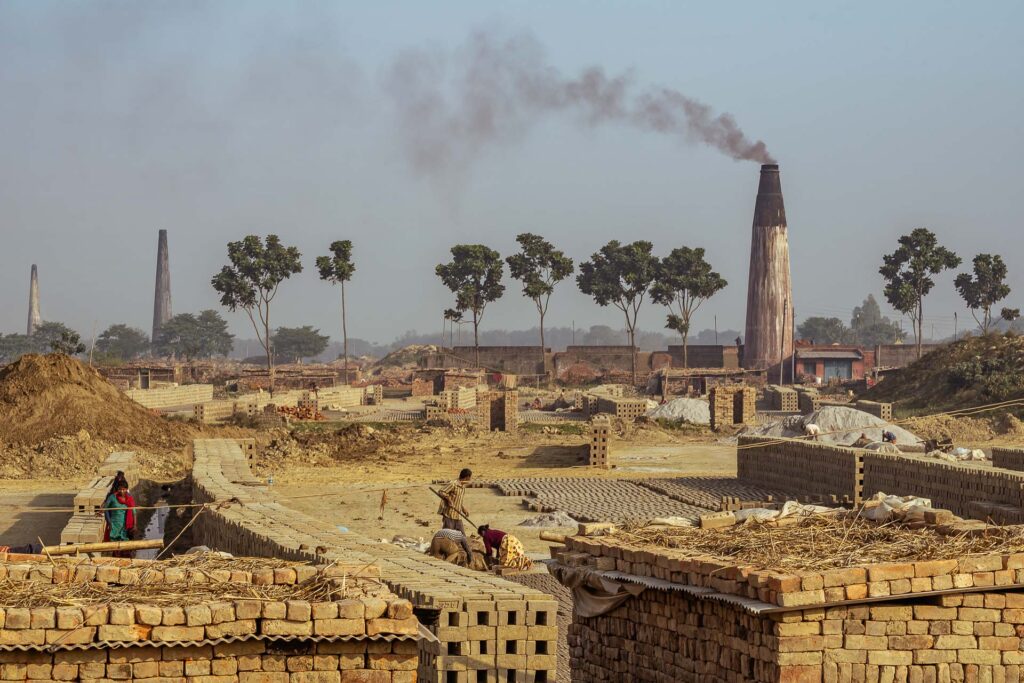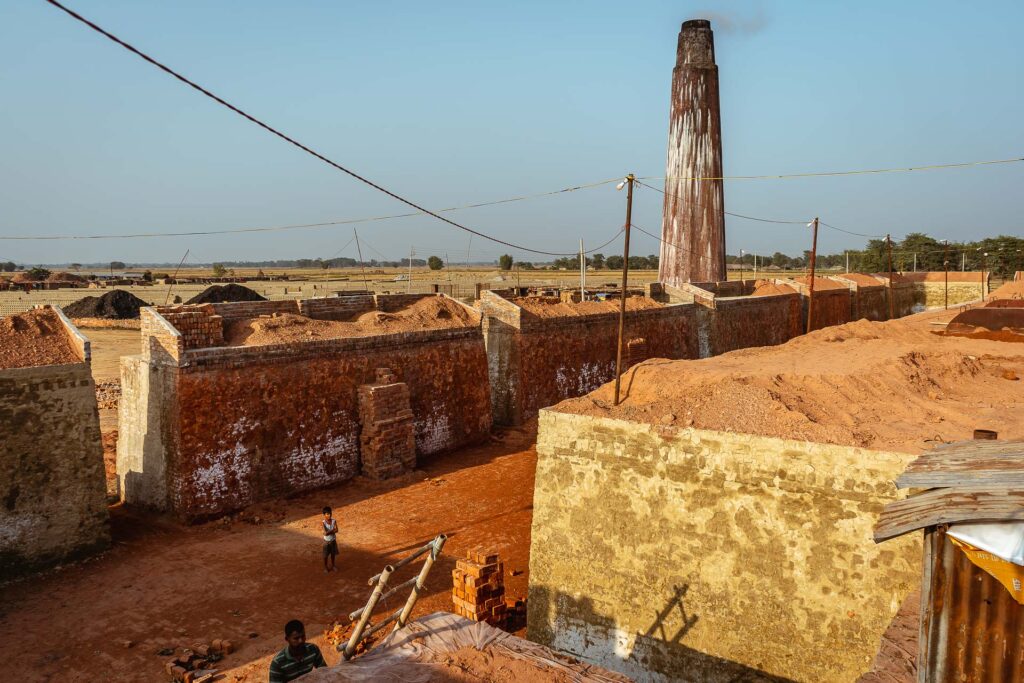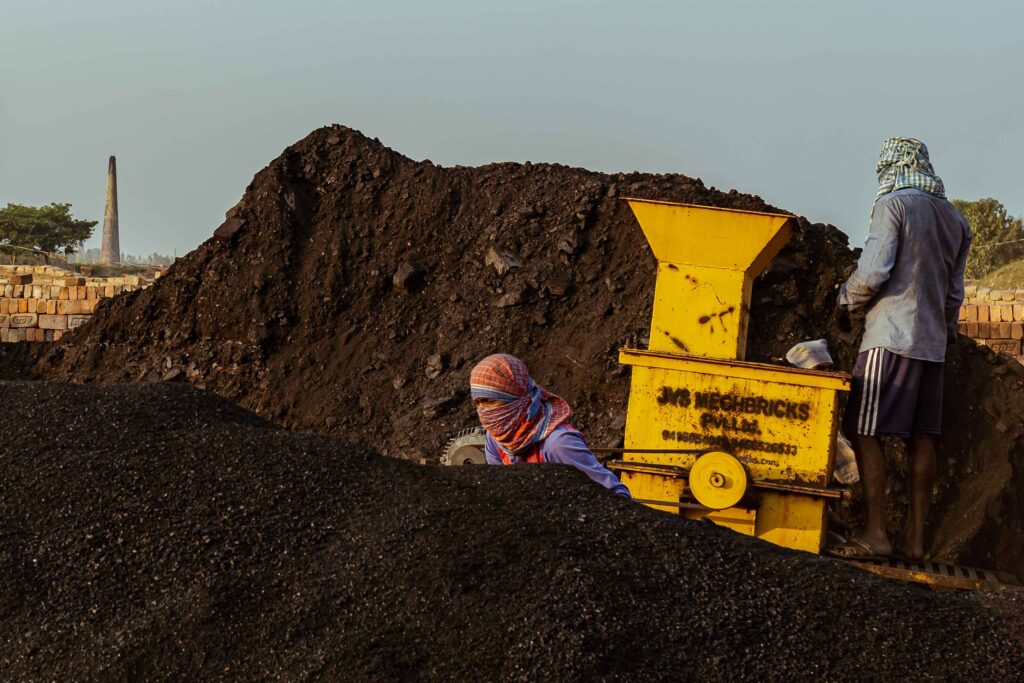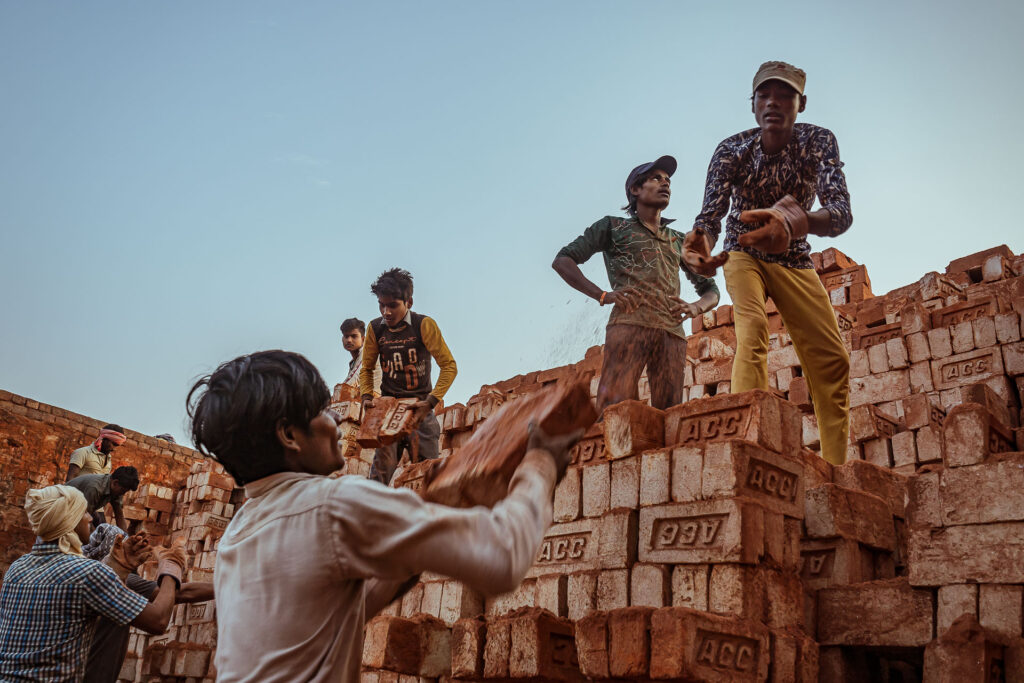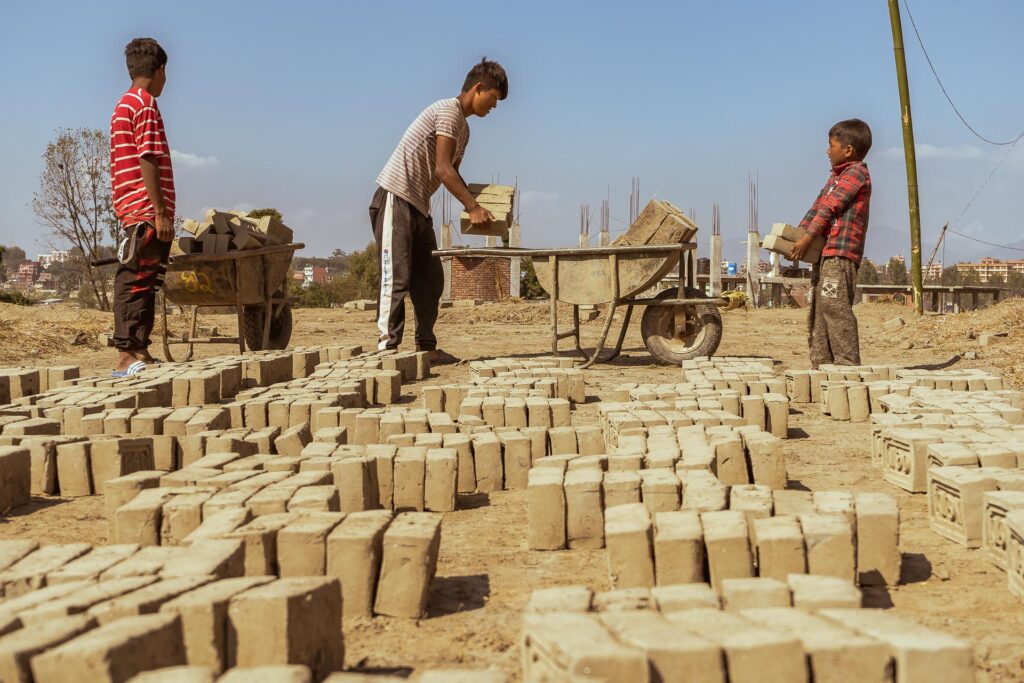In Nepal, according to the latest data, there are between 20,000 and 30,000 children working in brick kilns, a dangerous and unhealthy environment that seriously compromises their health. Most of these children no longer go to school, work long hours in the dust and smoke, and live in shacks near the kiln, without water or electricity. This reportage wants to show the harsh reality of work in the brick factories of Nepal and bring to light the conditions of these children, exploited for economic and social reasons and lack of controls; children who have been denied childhood, education and ultimately the possibility of a better future.

In November, the sunrise is cool and humid in the Terai, the flat area of southern Nepal close to the border with India. This tropical region, full of forests with rhinos and elephants and endless rice fields, is light years away from the idea that most of us have of Nepal. Or at least, of the idea that I had. Traveling by motorcycle on the dirt roads at this time of the day, you do not have a clear view, but from afar, you can see the tall chimneys of the brick kilns spewing clouds of dense black smoke that mixes with the fog of the morning, creating a gloomy and sinister landscape.
When we finally arrive, after almost an hour of travel, it is around six o’clock and there are already thirty workers who are unloading the fired bricks that are ready to be loaded into trucks and transported to the city. Men, women and many children swarm frantically among the red earth and brick dust. The workday begins before dawn when the temperature is still acceptable.
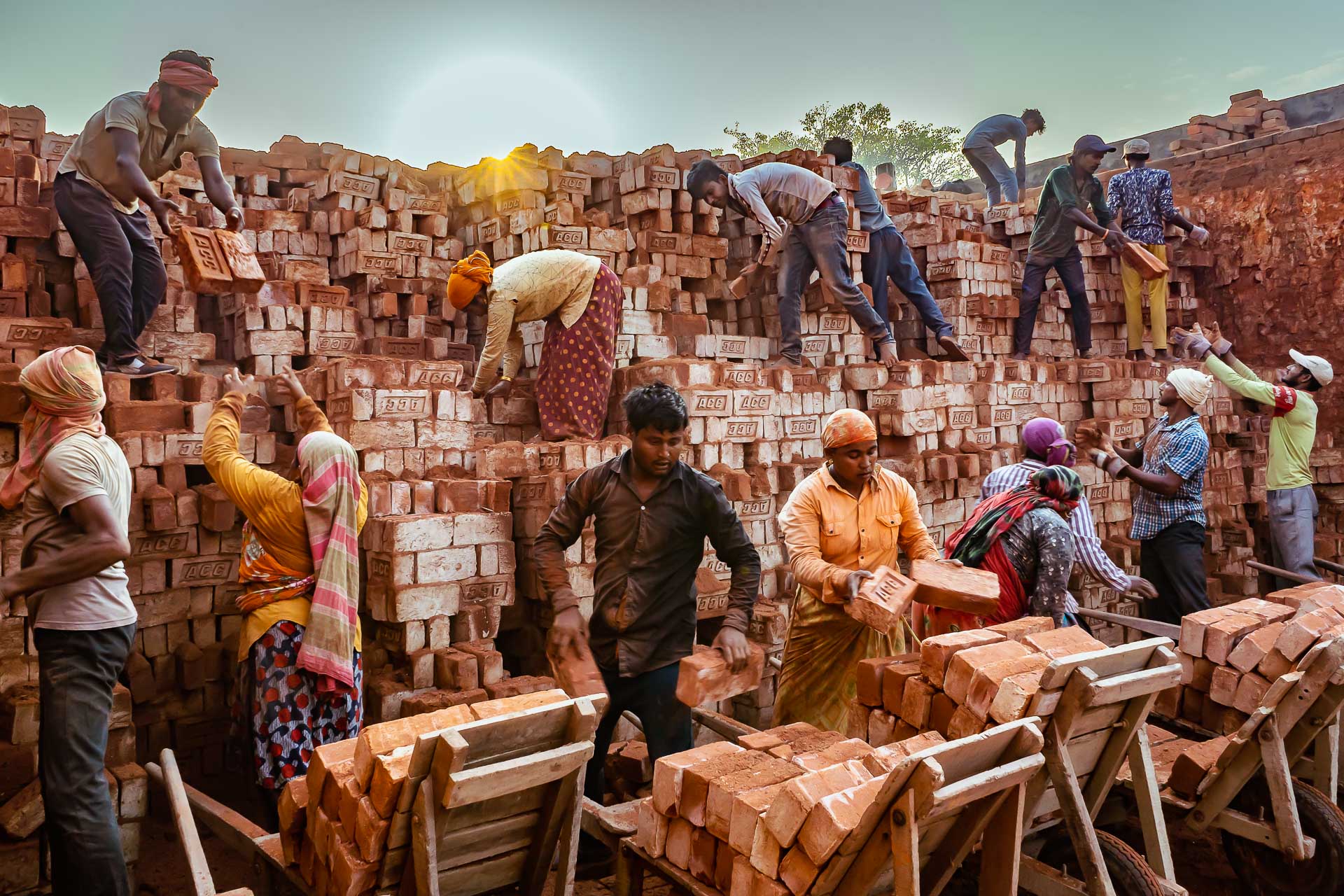
Once the sun is up it will be much more difficult to work and breathe this dense and dusty air. “We start before six and work until twelve or until we have finished unloading all the bricks. For every thousand bricks, they pay us two hundred rupees” —less than one euro fifty— “We came to Nepal because they pay more than in India”, Rajesh 32, tells me. With his wife Shaila (26) and his daughter Tamia (9) they are one of the many families that work and live inside the kiln. Like them, there are thousands of people that during the dry season, from November to March, migrate from India or from the poorer rural areas of Nepal to work in one of the approximately 1,000 factories present in the country. Although conditions are often inhumane, the brick industry employs thousands of unskilled workers: more than 300,000 people work in unsanitary and unsafe conditions in the kilns of Nepal. Brickmakers are some of the most marginalized and exploited unskilled laborers: they are often tied by debt to labor intermediaries and often earn wages that do not even allow them to pay recruiters’ advances.


Bricks are the main building material in Nepal. Clay, the main raw material, is available locally at a low cost and coal, the fuel used by the kilns, is imported from nearby India. In recent years, the brick industries in Nepal have boomed and become a source of income for many families and young children as the result of two tragic events: the 2015 earthquake and the Covid-19 pandemic. The catastrophic seismic event and the rapid urbanization of the country have boosted the demand for construction materials at cheap prices and, as a consequence, the presence of minors working in this industry has also increased. Furthermore, the 2020 pandemic, with the massive closure of schools and an unprecedented loss of jobs and income for millions of people, has exacerbated the situation. Many children have had to enter the workforce to help their families survive, finding an easy way out in the brick-making industry, an “informal sector” in which the hiring of workers is not formalized and no one receives or requests a contract.
According to a World Vision International survey that interviewed 618 parents in Nepal at the end of April 2020, 89% of people had seen their income drop by two-thirds or more since the start of the pandemic, and almost half of them were taking loans to meet his basic needs. The World Bank estimates that due to the effect of the pandemic, the number of people in extreme poverty (those who live on less than two dollars a day) grew from 88 to 93 million in 2020. When families lose part of their income, increase the chances of children being forced into the world of work. “Since school closed, I spent the whole day at home doing nothing. My parents lost their jobs, and we soon began to run out of money and food. I couldn’t bear this situation, so I decided to go to work, there was nothing else to do”, Drupadh, 13, the eldest son of a Nepalese family with five children, tells me. To help his parents and his siblings, he began to work, first in construction sites and later in brick kilns.
Before the Covid-19 pandemic, countries around the world had made remarkable progress in reducing child exploitation. According to the International Labor Organization (ILO), the number of child workers decreased by approximately 94 million between 2000 and 2016, representing a 38% drop. Nepal too had made remarkable progress in combating bonded labor practices. Nepal is a country of 8.7 Alliance that is fighting to accelerate progress towards Sustainable Development Goal 8.7: take immediate action to end modern slavery and ensure the elimination of child exploitation. However, joint reports by CBS, ILO and UNICEF indicate that bonded and forced labor still exists in the country’s private sector, including the brick industry.
The difficult economic situation, the closure of schools throughout the country and the limited access to distance learning (more than two thirds of children do not have access to a computer with Internet) have contributed decisively to the increase of child labor in Nepal. According to the latest data, in the Nepalese context, there are more than one million child workers (15% of the total population between 5 and 17 years old). Furthermore, more than 20% of these children work in dangerous environments such as the brick industry, agriculture or construction that are detrimental to their physical and mental health. Reports published in 2021 by ILO and United Nation ESCAP indicate that approximately 15% of the workforce in brick kilns in Nepal is made up of child laborers (between 20,000 and 30,000 children).
In the kilns, very young children are utilized to make bricks, while those who are slightly older are involved in digging, loading and unloading bricks into trucks. The payment procedure in the kilns is determined “per brick”: the more bricks they make or load, the greater the amount they will earn. If children work alongside their family, they are not counted as individual workers, but rather as helpers who increase the family’s productivity. There are also unaccompanied children, without legal guardians, who migrate seasonally (also across the border) with friends, relatives or naikes (labor contractors), making them more vulnerable and susceptible to trafficking.
Eisha and Manali, 11 and 8 years old, are two sisters from a small town in India near the border with Nepal. At first their deep black eyes look at me with mistrust and a bit of shame. They have never seen a Westerner wandering the brick factory, and they do not understand what I am doing with the camera in my hand. But when I get closer and we start talking, the distrust disappears in the time of a smile. They tell me that they also had to abandon their studies and start work. “I wish I could go back to school —Eisha tells me— but my family needs money and we can’t afford to pay for this. My parents have taken out loans during the pandemic and we have a lot of debts to pay off” and she adds,“It saddens me to think that my friends are now in school and we are here working. I don’t like working here, it’s a pain. I want to go back to study and get a good job”. Most of the children who, like Eisha and Manali, work in brick factories, are exposed to harsh conditions and an unsanitary environment that compromises their health. Many have problems with their hands, back and knees due to the repetitive movements they do most of the day, carrying heavy loads or sitting for long hours while making bricks. Dust and smoke from the kiln are also harmful to their eyes and lungs. The living conditions inside the kiln are also another cause that contributes to the suffering of minors and adults. The families that move to work in the brick industry live in shacks a few meters from the factory. They usually arrive in early November, as soon as the monsoon ends and the dry season begins, and they begin to build their houses (jyauli) by stacking one brick on top of the other. The roof of the huts is made of sheet metal, they do not have access to water and rarely to electricity. Up to six or seven people live in these small shacks, just over 1,5 meters high. These people represent the weakest and most vulnerable segment of society, unskilled workers who can only do this type of work and live in these conditions because they have no other skills, no education and, therefore, they have no other alternative. And in this way their children live and work as well.
In addition to economic conditions, in fact, there are also cultural aspects intrinsic to Nepalese society that contribute to the growth of child labor. One of them is parents education. According to a recent ILO study, the presence of child labor decreases as the level of parental education increases: the child labor rate is 4.4% in families where parents have a higher than secondary education while it rises to 18% in households in which the parents’ education is lower than secondary level.
Shanta and her husband Ayaan represent one of those family situations in which neither parent has completed the educational cycle. When we meet, it is almost four in the afternoon and they have been crouched there in the sun for at least ten hours. They have already made by hand several hundred bricks which will then be left to dry for a couple of weeks in the blazing sun, before being transported to the kiln and fired. To cope with the heat, Shanta only has a red pashmina wrapped around her face like a turban and a yellowish plastic bottle with some water that she filled from an irrigation pipe in the middle of the rice field. They come from the Rolpa region and every year, for more than six years, when the dry season arrives, they come to work in the Kathmandu Valley. The Baktahpur district, a few kilometers from the capital, is in fact one of the areas with the highest concentration of kilns of Nepal. More than two hundred brick kilns are concentrated in this zone, which makes it one of the most polluted in the country. “In one day my husband and I produce between 1,600 and 2,200 bricks, working around 15 hours —Shanta tells me— They pay us 1.3 rupees per brick”. Their eldest daughter, Sumita, 10 years old, no longer goes to school because, having this semi-nomadic life, she cannot pass the exams that allow her to access the following educational cycle: “I felt ashamed of being the oldest of my class and that’s why I decided to leave school and start working”. When I ask the parents if they are not worried about their daughter’s decision and her future, Ayaan replies that, since they are poor, they are forced to lead this life, and he does not see badly that the daughter helps the family. He also tells me he believes that it is normal and positive to start working and becoming independent from an early age.
The mentality of one part of society that considers child labor normal, the lack of government aid and the lack of controls over the application of laws make child labor still a very present and deeply rooted reality. Laws regulating this area, in fact, exist and are also numerous. To deal with this phenomenon, the Nepalese government has signed numerous regulations in recent years such as the 1999 Child Labor Act which states that no child under the age of 14 should be engaged in any work, and a violation could result in the incarceration of the employer or a fine of up to ten thousand rupees; or The Minimum Health and Safety Standards at Work for workers in the brick industry (2017), a directive that sets maximum working hours of adults and children, compensation for injuries, the weight that will be allowed to wear etc.
This increased attention and awareness of the problem has meant that there have been some small improvements in living and working conditions in some brick kilns. Part of the kilns, after being destroyed by the 2015 earthquake, have been rebuilt according to a new technology that is more efficient and more respectful of the environment; in some cases have been introduced some mechanical processes and some production tools such as gloves and wheelbarrows instead of allowing the transport of the bricks on the head. Thanks to the collaboration between the organization ICIMOD (International Center for Integrated Mountain Development) and the FNBI (Federation of Nepal Brick Industries), has also been drawn up an internal (and voluntary) ethic code that establishes practices and norms about work and life conditions in the kilns, and the goal of ending child exploitation. “When we talk about brick kilns there are two thoughts that come to mind: one is pollution and the other is the social issue. —Bydia Pradhan, regional program manager at ICIMOD tells me— Now we’re trying to tackle both. It’s not easy because if you ask brick kiln owners about the social problem, they won’t even listen to you. At least we are trying to encourage them, if there are very young children, to look after them and give them some basic materials so that they can go to school sometimes. We have seven “demonstration kilns” throughout Nepal and we also made, with the brick kiln owners association, a code of social conduct that includes the end of child labor, basic facilities and facilities for working women. We are trying to implement it throughout the country”.
However, despite the numerous efforts of governmental, private or non-governmental organizations to combat children exploitation, together with the formulation and ratification of numerous laws, child labor is still present, tolerated and seen by many poor families as an opportunity for an easy exit from poverty due to its immediate economic benefits. All this without realizing that working from a very young age negatively affects children’s health and education and ultimately their future.
“The children of today are the citizens of tomorrow. They are the key to the future; the more they properly transform into adults, the more the nation will prosper”. (ILO – Nepal child labor report 2021)
